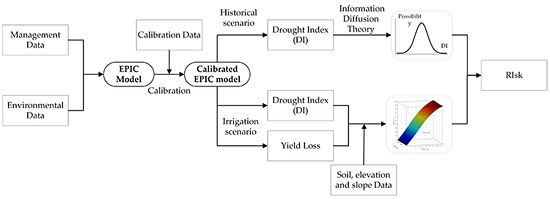Drought Risk Assessment Based on Vulnerability Surfaces: A Case Study of Maize
Abstract
:1. Introduction
2. Materials and Methods
2.1. Basic Idea and Research Framework
2.1.1. Assessment of Physical Vulnerability to Maize Drought
2.1.2. Assessment of Drought Intensity and Risk Based on Crop Model Simulation
2.1.3. Research Framework
2.2. Data
2.3. Methodology
2.3.1. Calibration of EPIC
2.3.2. Fitting of the Vulnerability Surface
2.3.3. Drought Risk Assessment Based on the Vulnerability Surface
3. Results
3.1. Calibration Results
3.2. “L-D-E” Vulnerability Surface of Maize
3.3. Maize Drought Risk on a Global Scale
4. Discussion
4.1. Relationship between CFRAG and Crops
4.2. Significance of Vulnerability Surfaces
4.3. Validity of Risk Assessment Results Based on the Vulnerability Surface
5. Conclusions
Acknowledgments
Author Contributions
Conflicts of Interest
Appendix A

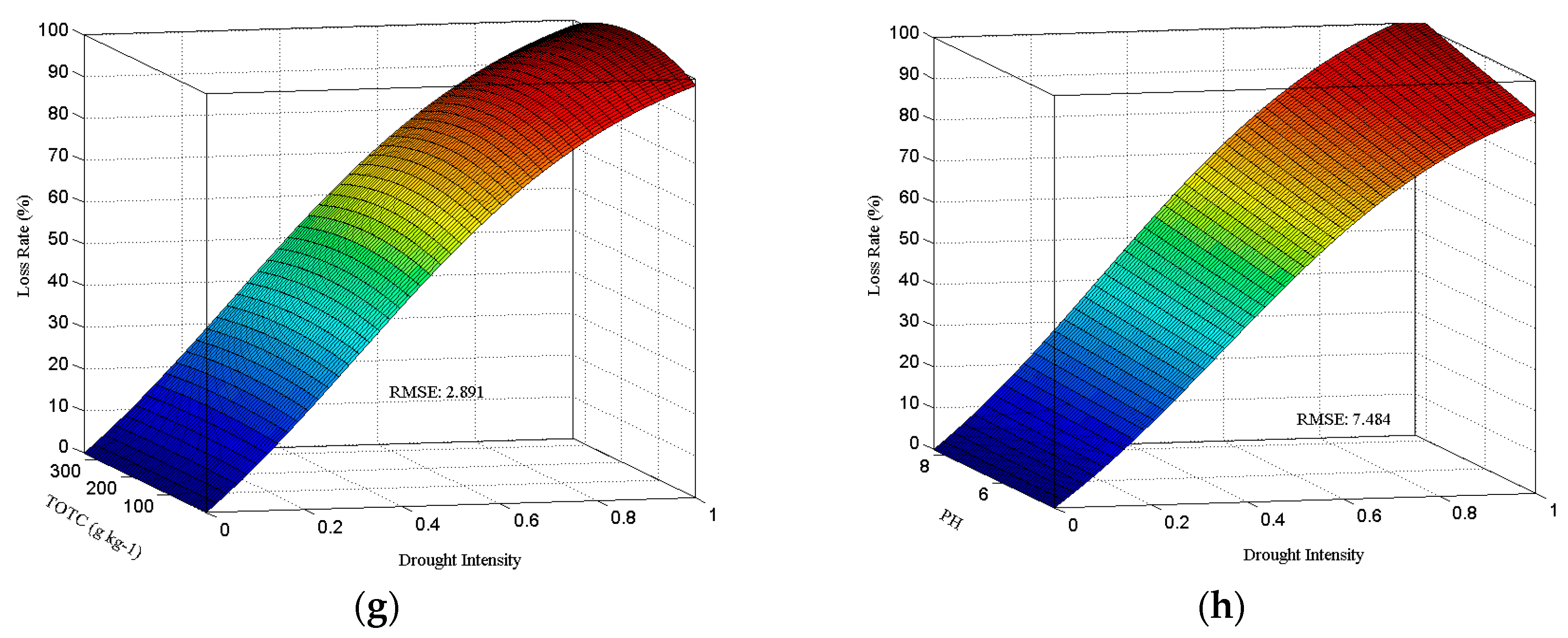
Appendix B
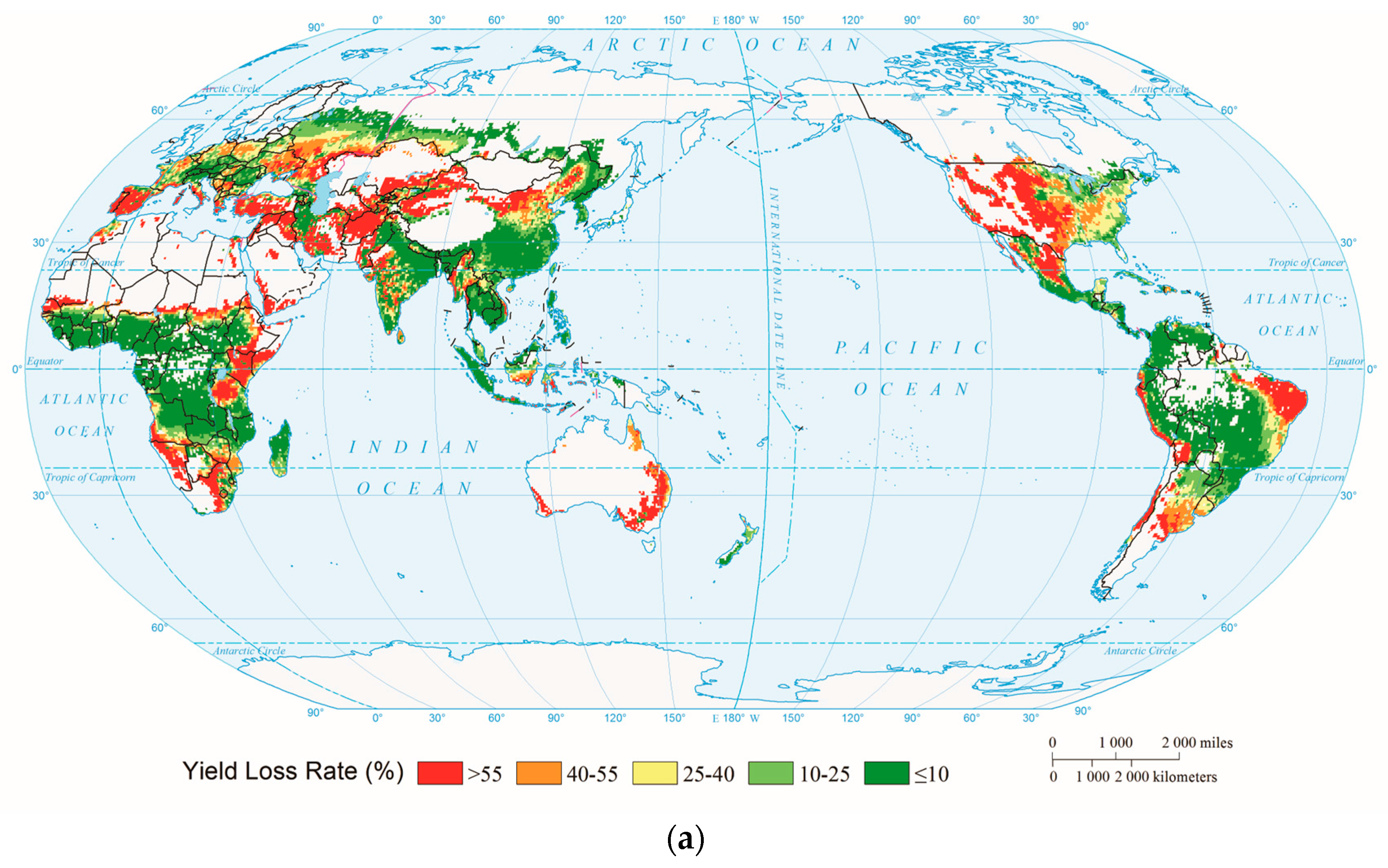
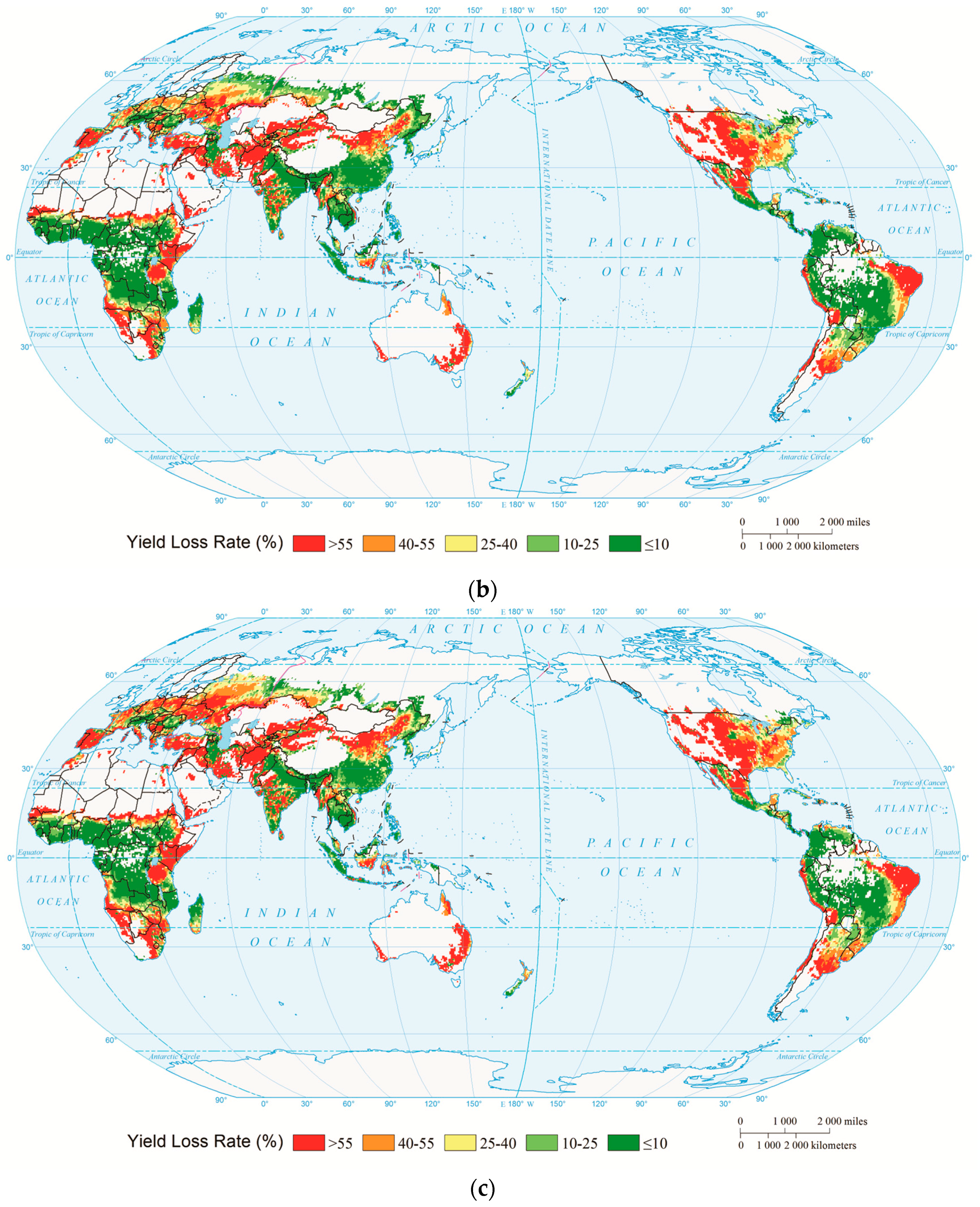
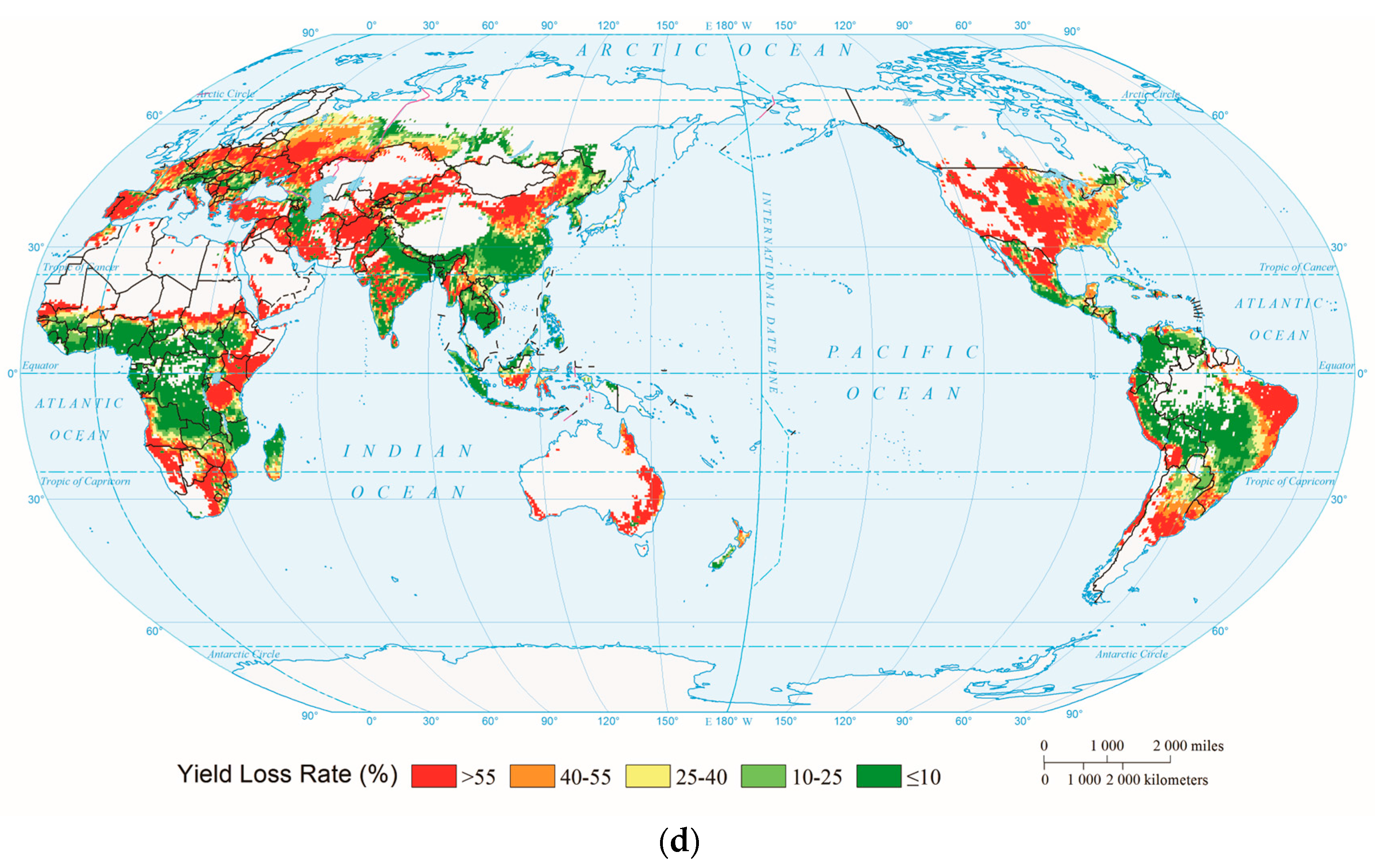
References
- Stocker, T.F. Climate Change 2013: The Physical Science Basis; Working group I Contribution to the Fifth Assessment Report of the Intergovernmental Panel on Climate Change; Cambridge University Press: Cambridge, UK, 2014. [Google Scholar]
- Kelley, C.P.; Mohtadi, S.; Cane, M.A.; Seager, R.; Kushnir, Y. Climate change in the fertile crescent and implications of the recent syrian drought. Proc. Natl. Acad. Sci. USA 2015, 112, 3241–3246. [Google Scholar] [CrossRef] [PubMed]
- Allen, C.D.; Macalady, A.K.; Chenchouni, H.; Bachelet, D.; McDowell, N.; Vennetier, M.; Kitzberger, T.; Rigling, A.; Breshears, D.D.; Hogg, E.T. A global overview of drought and heat-induced tree mortality reveals emerging climate change risks for forests. For. Ecol. Manag. 2010, 259, 660–684. [Google Scholar] [CrossRef]
- Gleick, P.H. Water, drought, climate change, and conflict in syria. Weather Clim. Soc. 2014, 6, 331–340. [Google Scholar] [CrossRef]
- Charpentier, A. Insurability of climate risks. Geneva Pap. Risk Insurance Issues Pract. 2008, 33, 91–109. [Google Scholar] [CrossRef]
- Rosenzweig, C.; Elliott, J.; Deryng, D.; Ruane, A.C.; Müller, C.; Arneth, A.; Boote, K.J.; Folberth, C.; Glotter, M.; Khabarov, N. Assessing agricultural risks of climate change in the 21st century in a global gridded crop model intercomparison. Proc. Natl. Acad. Sci. USA 2014, 111, 3268–3273. [Google Scholar] [CrossRef] [PubMed]
- Pelling, M.; Maskrey, A.; Ruiz, P.; Hall, L.; Peduzzi, P.; Dao, Q.-H.; Mouton, F.; Herold, C.; Kluser, S. Reducing Disaster Risk: A Challenge for Development; United Nations Development Programme: New York, NY, USA, 2004. [Google Scholar]
- Palmer, W.C. Meteorological Drought; US Department of Commerce, Weather Bureau: Washington, DC, USA, 1965; Volume 30.
- McKee, T.B.; Doesken, N.J.; Kleist, J. The relationship of drought frequency and duration to time scales. In Proceedings of the 8th Conference on Applied Climatology, Anaheim, CA, USA, 17–22 January 1993; pp. 179–183.
- Dalezios, N.; Blanta, A.; Spyropoulos, N.; Tarquis, A. Risk identification of agricultural drought for sustainable agroecosystems. Nat. Hazards Earth Syst. Sci. 2014, 14, 2435–2448. [Google Scholar] [CrossRef]
- Woli, P.; Jones, J.; Ingram, K.; Paz, J. Forecasting drought using the agricultural reference index for drought (arid): A case study. Weather Forecast. 2013, 28, 427–443. [Google Scholar] [CrossRef]
- Chongfu, H. Principle of information diffusion. Fuzzy Sets Syst. 1997, 91, 69–90. [Google Scholar] [CrossRef]
- Dai, A. Characteristics and trends in various forms of the palmer drought severity index during 1900–2008. J. Geophys. Res. Atmos. 2011, 116. [Google Scholar] [CrossRef]
- Mpelasoka, F.; Hennessy, K.; Jones, R.; Bates, B. Comparison of suitable drought indices for climate change impacts assessment over australia towards resource management. Int. J. Climatol. 2008, 28, 1283–1292. [Google Scholar] [CrossRef]
- Conde, C.; Liverman, D.; Flores, M.; Ferrer, R.; Araújo, R.; Betancourt, E.; Villarreal, G.; Gay, C. Vulnerability of rainfed maize crops in Mexico to climate change. Clim. Res. 1998, 9, 17–23. [Google Scholar] [CrossRef]
- Pogson, M.; Hastings, A.; Smith, P. Sensitivity of crop model predictions to entire meteorological and soil input datasets highlights vulnerability to drought. Environ. Model. Softw. 2012, 29, 37–43. [Google Scholar] [CrossRef]
- Dilley, M. Natural Disaster Hotspots: A Global Risk Analysis; World Bank Publications: Washington, DC, USA, 2005; Volume 5. [Google Scholar]
- Antwi-Agyei, P.; Fraser, E.D.; Dougill, A.J.; Stringer, L.C.; Simelton, E. Mapping the vulnerability of crop production to drought in Ghana using rainfall, yield and socioeconomic data. Appl. Geogr. 2012, 32, 324–334. [Google Scholar] [CrossRef]
- Simelton, E.; Fraser, E.D.; Termansen, M.; Forster, P.M.; Dougill, A.J. Typologies of crop-drought vulnerability: An empirical analysis of the socio-economic factors that influence the sensitivity and resilience to drought of three major food crops in China (1961–2001). Environ. Sci. Policy 2009, 12, 438–452. [Google Scholar] [CrossRef]
- Wu, H.; Wilhite, D.A. An operational agricultural drought risk assessment model for Nebraska, USA. Nat. Hazards 2004, 33, 1–21. [Google Scholar] [CrossRef]
- Jayanthi, H.; Husak, G.J.; Funk, C.; Magadzire, T.; Chavula, A.; Verdin, J.P. Modeling rain-fed maize vulnerability to droughts using the standardized precipitation index from satellite estimated rainfall—Southern Malawi case study. Int. J. Disaster Risk Reduct. 2013, 4, 71–81. [Google Scholar] [CrossRef]
- Wang, Z.; He, F.; Fang, W.; Liao, Y. Assessment of physical vulnerability to agricultural drought in China. Nat. Hazards 2013, 67, 645–657. [Google Scholar] [CrossRef]
- Li, Y.; Sperry, J.S.; Shao, M. Hydraulic conductance and vulnerability to cavitation in corn (Zea mays L.) hybrids of differing drought resistance. Environ. Exp. Bot. 2009, 66, 341–346. [Google Scholar] [CrossRef]
- Ming, X.; Xu, W.; Li, Y.; Du, J.; Liu, B.; Shi, P. Quantitative multi-hazard risk assessment with vulnerability surface and hazard joint return period. Stoch. Environ. Res. Risk Assess. 2015, 29, 35–44. [Google Scholar] [CrossRef]
- Birkmann, J. Risk and vulnerability indicators at different scales: Applicability, usefulness and policy implications. Environ. Hazards 2007, 7, 20–31. [Google Scholar] [CrossRef]
- White, G.F. Choice of Adjustment to Floods; University of Chicago: Chicago, IL, USA, 1964; p. 150. [Google Scholar]
- Smith, D. Flood damage estimation—A review of urban stage-damage curves and loss functions. Water SA 1994, 20, 231–238. [Google Scholar]
- Jayanthi, H.; Husak, G.J.; Funk, C.; Magadzire, T.; Adoum, A.; Verdin, J.P. A probabilistic approach to assess agricultural drought risk to maize in Southern Africa and millet in Western Sahel using satellite estimated rainfall. Int. J. Disaster Risk Reduct. 2014, 10, 490–502. [Google Scholar] [CrossRef]
- Jia, H.; Wang, J.; Cao, C.; Pan, D.; Shi, P. Maize drought disaster risk assessment of china based on EPIC model. Int. J. Digit. Earth 2012, 5, 488–515. [Google Scholar] [CrossRef]
- Yin, Y.; Zhang, X.; Lin, D.; Yu, H.; Shi, P. GEPIC-VR model: A GIS-based tool for regional crop drought risk assessment. Agric. Water Manag. 2014, 144, 107–119. [Google Scholar] [CrossRef]
- Lee, K.H.; Rosowsky, D.V. Fragility analysis of woodframe buildings considering combined snow and earthquake loading. Struct. Saf. 2006, 28, 289–303. [Google Scholar] [CrossRef]
- Wang, Z.; Song, W.; Li, T. Combined fragility surface analysis of earthquake and scour hazards for bridge. In Proceedings of the 15th World Conference on Earthquake Engineering, Lisbon, Portugal, 28 September 2012; pp. 24–28.
- McCarthy, J.J. Climate Change 2001: Impacts, Adaptation, and Vulnerability; Contribution of Working Group II to the Third Assessment Report of the Intergovernmental Panel on Climate Change; Cambridge University Press: Cambridge, UK, 2001. [Google Scholar]
- Barros, V.; Field, C.; Dokke, D.; Mastrandrea, M.; Mach, K.; Bilir, T.; Chatterjee, M.; Ebi, K.; Estrada, Y.; Genova, R. Climate Change 2014: Impacts, Adaptation, and Vulnerability: Part B: Regional Aspects; Contribution of working Group II to the Fifth Assessment Report of the Intergovernmental Panel on Climate Change; Cambridge University Press: Cambridge, UK; New York, NY, USA, 2014. [Google Scholar]
- Challinor, A.; Wheeler, T.; Garforth, C.; Craufurd, P.; Kassam, A. Assessing the vulnerability of food crop systems in Africa to climate change. Clim. Chang. 2007, 83, 381–399. [Google Scholar] [CrossRef]
- Williams, J.; Jones, C.; Kiniry, J.; Spanel, D.A. The EPIC crop growth model. Trans. ASAE 1989, 32, 497–511. [Google Scholar] [CrossRef]
- Hempel, S.; Frieler, K.; Warszawski, L.; Schewe, J.; Piontek, F. A trend-preserving bias correction—The ISI-MIP approach. Earth Syst. Dyn. 2013, 4, 219–236. [Google Scholar] [CrossRef]
- United States Geological Survey (USGS). Available online: https://lta.cr.usgs.gov/GTOPO30 (accessed on 21 June 2013).
- International Institute for Applied Systems Analysis-Global Agro-Ecological Zones (GAEZ). Available online: http://www.gaez.iiasa.ac.at (accessed on 11 December 2012).
- International Soil Reference and Information Centre (ISRIC). Available online: http://www.isric.org/data/isric-wise-derived-soil-properties-5-5-arc-minutes-global-grid-version-12 (accessed on 14 October 2013).
- German Federal Ministry of Education and Research (BMBF): The ISIMIP Fast Track Project. Available online: https://www.isimip.org/outputdata (accessed on 14 October 2013).
- University of Wisconsin-Madison: Sustainability and the Global Environment (SAGE). Available online: http://nelson.wisc.edu/sage/data-and-models/datasets.php (accessed on 27 July 2014).
- University of Wisconsin-Madison Sustainability and the Global Environment (SAGE). Available online: http://nelson.wisc.edu/sage/data-and-models/crop-calendar-dataset/index.php (accessed on 29 June 2014).
- The University of Tokyo (OKI Laboratory). Available online: http://hydro.iis.u-tokyo.ac.jp/GW/result/global/annual/withdrawal/index.html (accessed on 19 June 2014).
- Land Use and the Global Environment (LUGE). Available online: http://www.ramankuttylab.com/data.html (accessed on 26 March 2014).
- Food and Agriculture Organization (FAO). Available online: http://faostat.fao.org (accessed on 26 March 2014).
- Fischer, G.; Nachtergaele, F.; Prieler, S.; Teixeira, E.; Tóth, G.; van Velthuizen, H.; Verelst, L.; Wiberg, D. Global Agro-Ecological Zones (Gaez v3. 0): Model Documentation; International Institute for Applied Systems Analysis (IIASA): Laxenburg, Austria, 2012; Austria and the Food and Agriculture Organization of the United Nations (FAO): Rome, Italy, 2012.
- Batjes, N. Isric-Wise Derived Soil Properties on a 5 by 5 Arc-Minutes Global Grid (ver. 1.2); ISRIC: Wageningen, The Netherlands, 2012. [Google Scholar]
- Monfreda, C.; Ramankutty, N.; Foley, J.A. Farming the planet: 2. Geographic distribution of crop areas, yields, physiological types, and net primary production in the year 2000. Glob. Biogeochem. Cycles 2008, 22. [Google Scholar] [CrossRef]
- Sacks, W.J.; Deryng, D.; Foley, J.A.; Ramankutty, N. Crop planting dates: An analysis of global patterns. Glob. Ecol. Biogeogr. 2010, 19, 607–620. [Google Scholar] [CrossRef]
- Tan, G.; Shibasaki, R. Global estimation of crop productivity and the impacts of global warming by GIS and EPIC integration. Ecol. Model. 2003, 168, 357–370. [Google Scholar] [CrossRef]
- Potter, P.; Ramankutty, N.; Bennett, E.M.; Donner, S.D. Characterizing the spatial patterns of global fertilizer application and manure production. Earth Interact. 2010, 14, 1–22. [Google Scholar] [CrossRef]
- De Barros, I.; Williams, J.R.; Gaiser, T. Modeling soil nutrient limitations to crop production in semiarid ne of Brazil with a modified EPIC version II: Field test of the model. Ecol. Model. 2005, 181, 567–580. [Google Scholar] [CrossRef]
- Gaiser, T.; de Barros, I.; Sereke, F.; Lange, F.-M. Validation and reliability of the EPIC model to simulate maize production in small-holder farming systems in tropical sub-humid West Africa and semi-arid Brazil. Agric. Ecosyst. Environ. 2010, 135, 318–327. [Google Scholar] [CrossRef]
- Wang, X.C.; Li, J. Evaluation of crop yield and soil water estimates using the EPIC model for the loess plateau of China. Math. Comput. Model. 2010, 51, 1390–1397. [Google Scholar] [CrossRef]
- Wang, X.C.; Li, J.; Tahir, M.N.; De Hao, M. Validation of the EPIC model using a long-term experimental data on the semi-arid loess plateau of China. Math. Comput. Model. 2011, 54, 976–986. [Google Scholar] [CrossRef]
- Huang, C.; Moraga, C. Extracting fuzzy if–then rules by using the information matrix technique. J. Comput. Syst. Sci. 2005, 70, 26–52. [Google Scholar] [CrossRef]
- Hao, L.; Zhang, X.; Liu, S. Risk assessment to China’s agricultural drought disaster in county unit. Nat. Hazards 2012, 61, 785–801. [Google Scholar] [CrossRef]
- Khakural, B.; Robert, P.; Mulla, D. Relating Corn/Soybean Yield to Variability in Soil and Landscape Characteristics. Available online: https://dl.sciencesocieties.org/publications/books/abstracts/acsesspublicati/precisionagricu3/117 (accessed on 15 August 2016).
- Grewal, S.; Singh, K.; Dyal, S. Soil profile gravel concentration and its effect on rainfed crop yields. Plant Soil 1984, 81, 75–83. [Google Scholar] [CrossRef]
- Leenaars, J.; Hengl, T.; González, M.R.; de Jesus, J.M.; Heuvelink, G.; Wolf, J.; van Bussel, L.; Claessens, L.; Yang, H.; Cassman, K. Root Zone Plant-Available Water Holding Capacity of the Sub-Saharan Africa Soil, Version 1.0. Gridded Functional Soil Information (Dataset RZ-PAWHC SSA v. 1.0); ISRIC Report; ISRIC: Wageningen, The Netherlands, 2015; Volume 2. [Google Scholar]
- Wang, G. Agricultural drought in a future climate: Results from 15 global climate models participating in the IPCC 4th assessment. Clim. Dyn. 2005, 25, 739–753. [Google Scholar] [CrossRef]
- Sheffield, J.; Wood, E.F. Projected changes in drought occurrence under future global warming from multi-model, multi-scenario, IPCC AR4 simulations. Clim. Dyn. 2008, 31, 79–105. [Google Scholar] [CrossRef]
- Li, Y.; Ye, W.; Wang, M.; Yan, X. Climate change and drought: A risk assessment of crop-yield impacts. Clim. Res. 2009, 39, 31–46. [Google Scholar] [CrossRef]
- Burke, E.J.; Brown, S.J.; Christidis, N. Modeling the recent evolution of global drought and projections for the twenty-first century with the hadley centre climate model. J. Hydrometeorol. 2006, 7, 1113–1125. [Google Scholar] [CrossRef]
- Dai, A. Increasing drought under global warming in observations and models. Nat. Clim. Chang. 2013, 3, 52–58. [Google Scholar] [CrossRef]
- Yin, Y.; Zhang, X.; Yu, H.; Lin, D.; Wu, Y. Mapping drought risk (maize) of the world. In World Atlas of Natural Disaster Risk; Springer: Berlin, Germany, 2015; pp. 211–226. [Google Scholar]
- Zhang, X.; Guo, H.; Yin, W.; Wang, R.; Li, J.; Yue, Y. Mapping drought risk (wheat) of the world. In World Atlas of Natural Disaster Risk; Springer: Berlin, Germany, 2015; pp. 227–242. [Google Scholar]
- Zhang, X.; Lin, D.; Guo, H.; Wu, Y. Mapping drought risk (rice) of the world. In World Atlas of Natural Disaster Risk; Springer: Berlin, Germany, 2015; pp. 243–258. [Google Scholar]
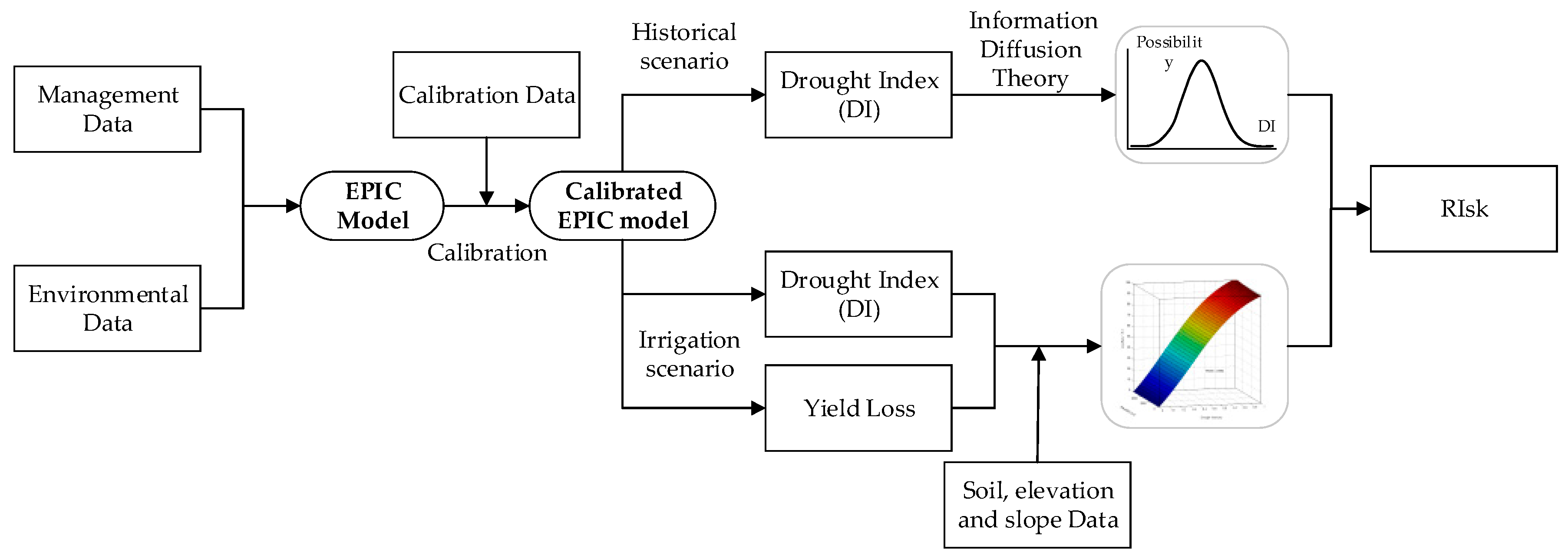
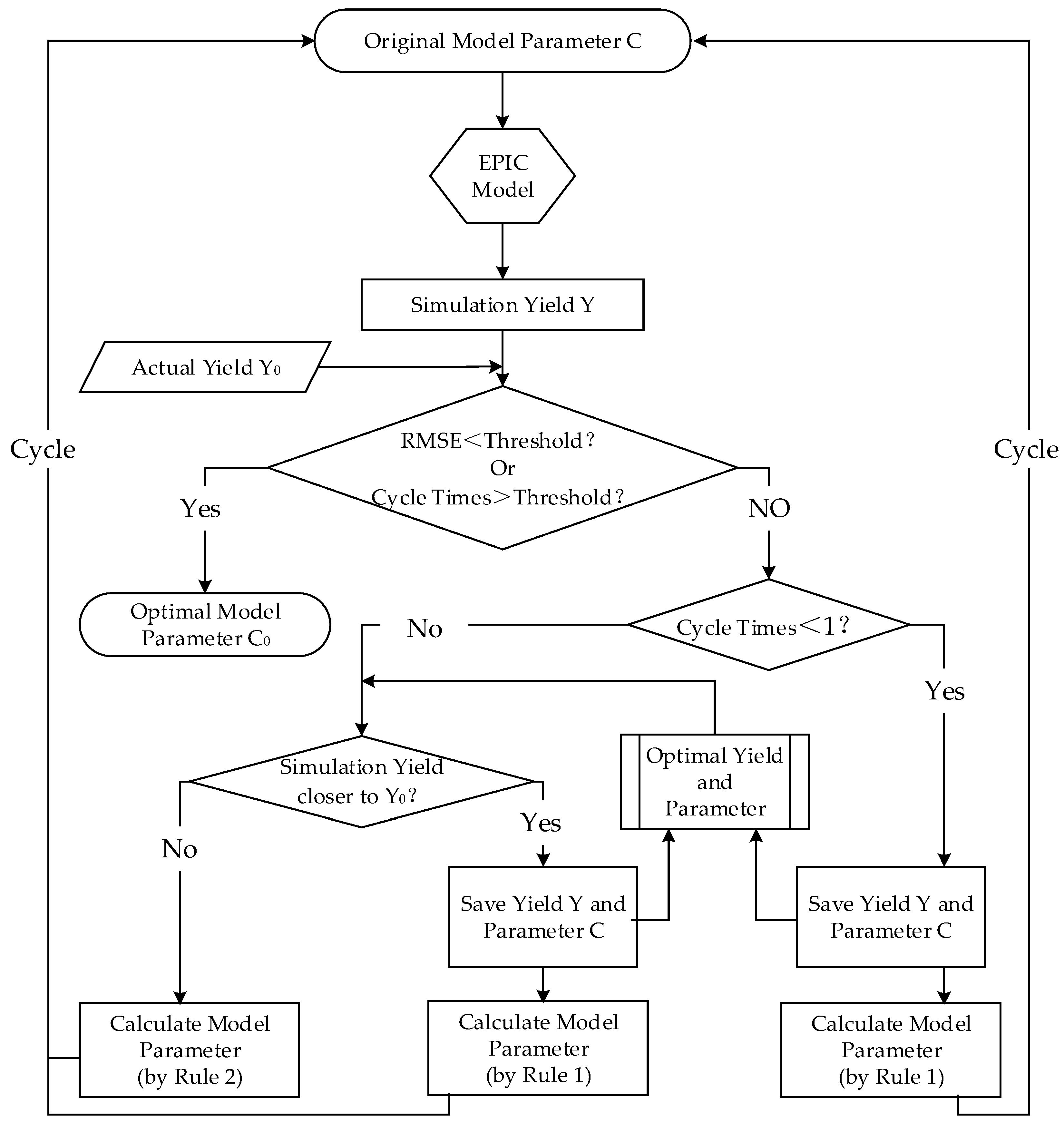
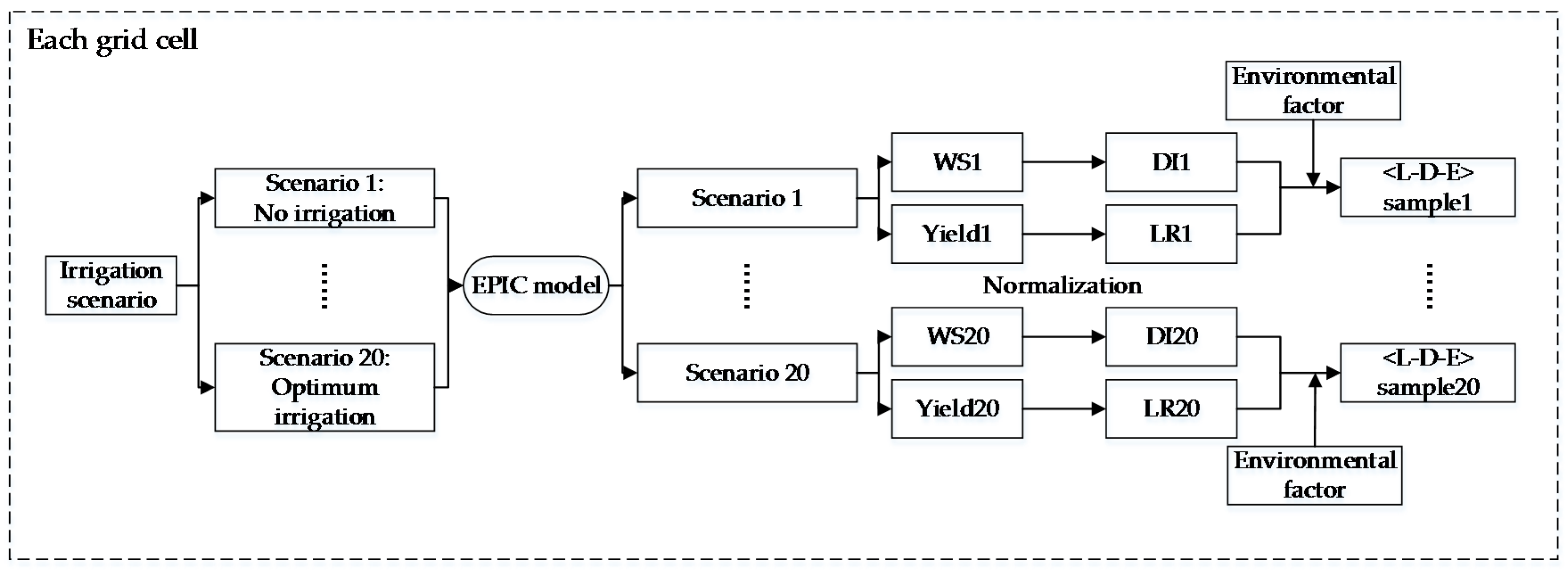


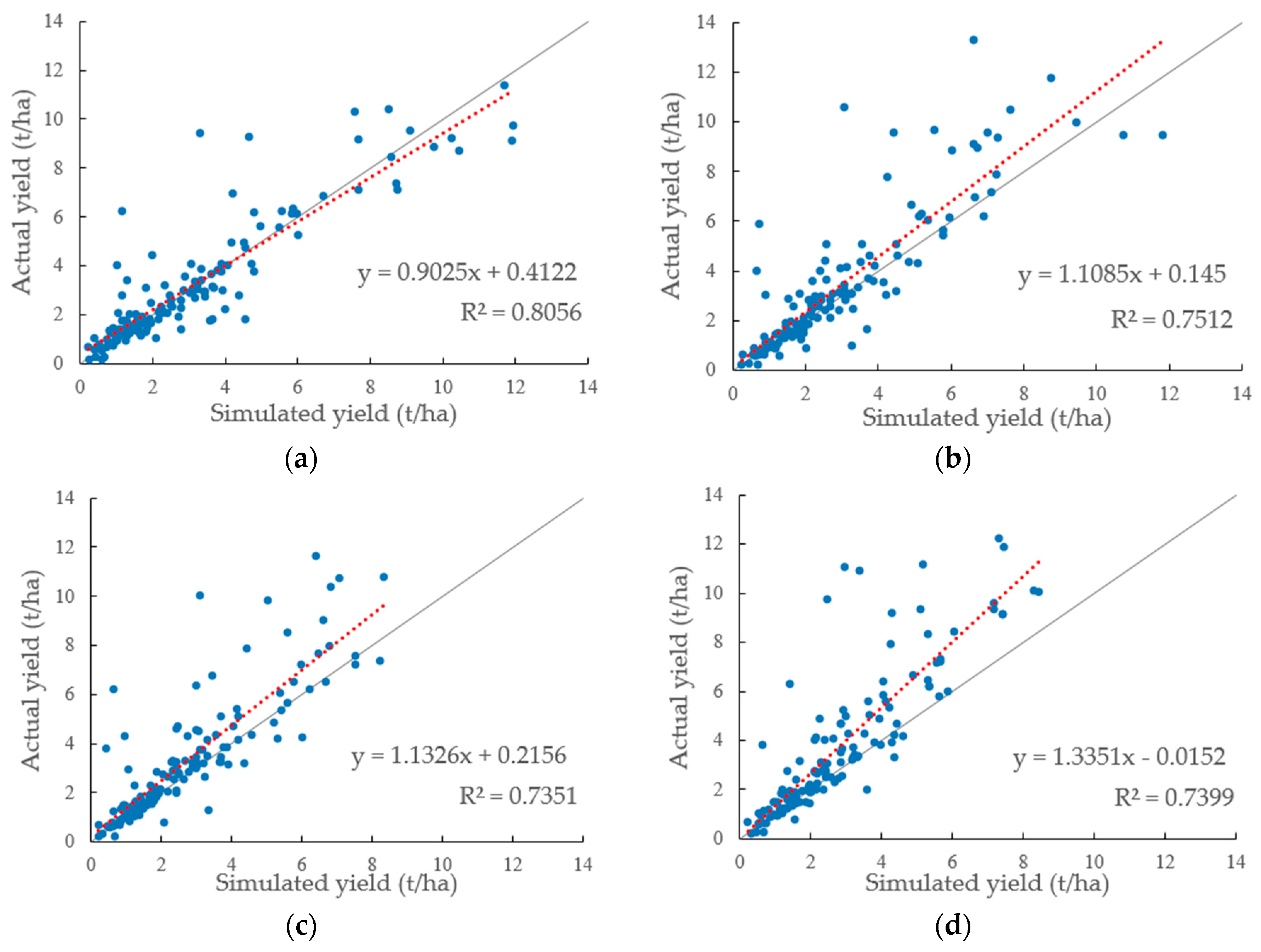



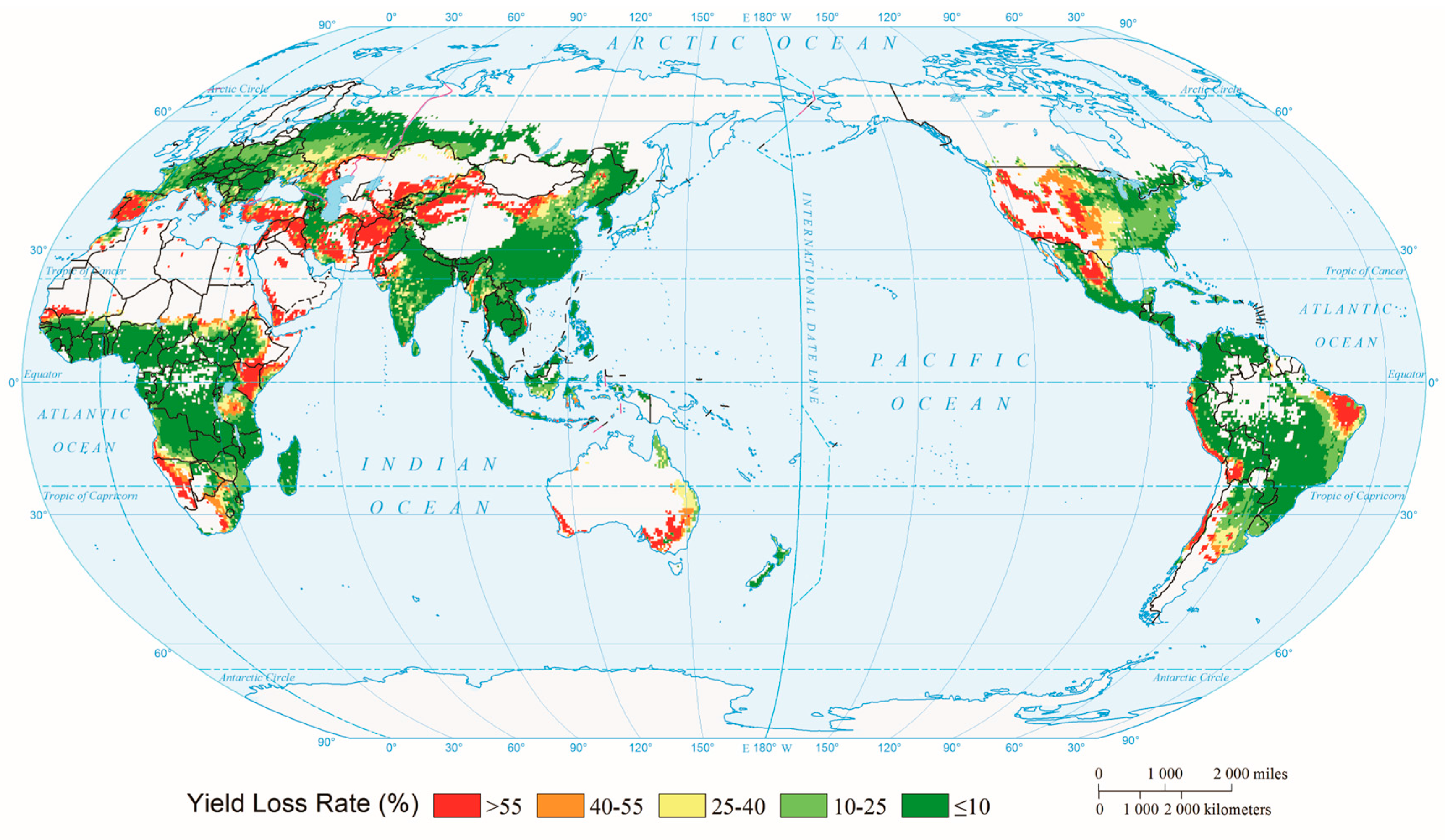
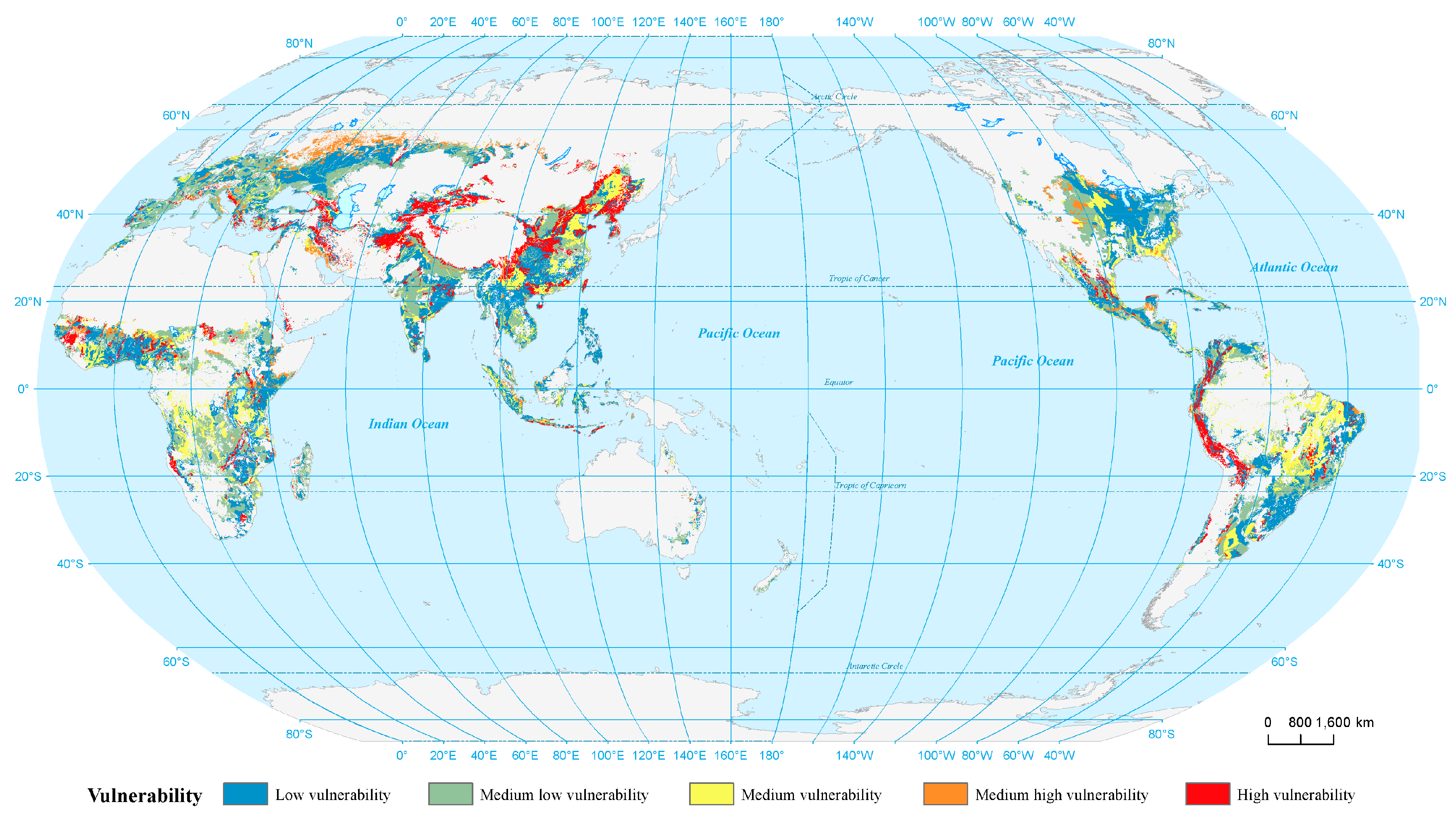
| Data Category | Name | Source | Spatial Resolution | Temporal Resolution |
|---|---|---|---|---|
| Geographical environmental data | DEM | United States Geological Survey (USGS) [38] | 0.0833° × 0.0833° | 1996 |
| Slope | International Institute for Applied Systems Analysis-Global Agro-Ecological Zones (GAEZ) [39] | 0.0833° × 0.0833° | 2002 | |
| Soil | International Soil Reference and Information Centre (ISRIC) [40] | 0.0833° × 0.0833° | 2012 | |
| Meteorological | German Federal Ministry of Education and Research (BMBF):The ISIMIP Fast Track project [41] | 0.5° × 0.5° | 1971–2099 | |
| Extent of maize | University of Wisconsin-Madison: Sustainability and the Global Environment (SAGE) [42] | 0.0833° × 0.0833° | 2000 | |
| Field management data | Growth period of maize | University of Wisconsin-Madison Sustainability and the Global Environment (SAGE) [43] | 0.5° × 0.5° | 2010 |
| Irrigation | The University of Tokyo (OKI Laboratory) [44] | 0.5° × 0.5° | 2010 | |
| Fertilizer | Land Use and the Global Environment (LUGE) [45] | 0.5° × 0.5° | 2011 | |
| Calibration data | Actual yield of global maize | Food and Agriculture Organization (FAO) [46] | National (regional) unit | 2000–2004 |
| Indicator | a | b | c | d | e | f | R2 | RMSE |
|---|---|---|---|---|---|---|---|---|
| Elevation | 384.01 | 0.35 | 3.39 | 1.09 × 10−7 | 1167.23 | 99.12 | 0.99339 | 2.89636 |
| Slope | −90.22 | 0.35 | 3.39 | 3.91 × 10−5 | −164.39 | 97.98 | 0.99338 | 2.89996 |
| CFRAG | −15.65 | 0.36 | 3.36 | 0.007 | 10.94 | 98.88 | 0.99342 | 2.89062 |
| BULK | 0.44 | 0.29 | 3.52 | 0.41 | −13.75 | 2.62 | 0.95518 | 7.54344 |
| TAWC | 9.71 | 0.29 | 3.52 | 0.0008 | −184.18 | 64.82 | 0.95620 | 7.45699 |
| SDTO | 100.32 | 0.35 | 3.40 | −0.00018 | 26.51 | 99.34 | 0.99338 | 2.89889 |
| CLPC | −421.92 | 0.36 | 3.37 | −0.0015 | 6.91 | 99.80 | 0.99334 | 2.90779 |
| TOTC | 103.86 | 0.35 | 3.38 | −0.00019 | 171.47 | 103.81 | 0.99342 | 2.89104 |
| PH | 0.44 | 0.30 | 3.49 | 0.02 | −54.39 | 21.87 | 0.95589 | 7.48403 |
| Country | Maximum Yield Loss Rate (%) | Minimum Yield Loss Rate (%) | Average Yield Loss Rate (%) |
|---|---|---|---|
| Afghanistan | 93.85 | 0 | 67.63 |
| Australia | 92.23 | 0.45 | 48.00 |
| Brazil | 83.32 | 0 | 11.59 |
| Chile | 100 | 0.06 | 64.64 |
| China | 99.97 | 0 | 19.75 |
| Iraq | 99.48 | 7.96 | 70.32 |
| Spain | 98.91 | 0 | 51.46 |
| United States | 97.26 | 0.03 | 30.52 |
| Continent | Normalized Value of Risk in This Study | Normalized Value of Risk in Li’s Study |
|---|---|---|
| North America | 1 | 0.30 |
| Europe | 0.64 | 0.22 |
| Africa | 0.96 | 1 |
| South America | 0.64 | 0.37 |
| Oceania | 0.15 | 0 |
| Southern Asia | 0.07 | 0.25 |
| South East Asia | 0 | 0.22 |
| Eastern Asia | 0.56 | 0.29 |
| Middle East | 0.80 | 0.43 |
© 2016 by the authors; licensee MDPI, Basel, Switzerland. This article is an open access article distributed under the terms and conditions of the Creative Commons Attribution (CC-BY) license (http://creativecommons.org/licenses/by/4.0/).
Share and Cite
Guo, H.; Zhang, X.; Lian, F.; Gao, Y.; Lin, D.; Wang, J. Drought Risk Assessment Based on Vulnerability Surfaces: A Case Study of Maize. Sustainability 2016, 8, 813. https://doi.org/10.3390/su8080813
Guo H, Zhang X, Lian F, Gao Y, Lin D, Wang J. Drought Risk Assessment Based on Vulnerability Surfaces: A Case Study of Maize. Sustainability. 2016; 8(8):813. https://doi.org/10.3390/su8080813
Chicago/Turabian StyleGuo, Hao, Xingming Zhang, Fang Lian, Yuan Gao, Degen Lin, and Jing’ai Wang. 2016. "Drought Risk Assessment Based on Vulnerability Surfaces: A Case Study of Maize" Sustainability 8, no. 8: 813. https://doi.org/10.3390/su8080813
APA StyleGuo, H., Zhang, X., Lian, F., Gao, Y., Lin, D., & Wang, J. (2016). Drought Risk Assessment Based on Vulnerability Surfaces: A Case Study of Maize. Sustainability, 8(8), 813. https://doi.org/10.3390/su8080813




